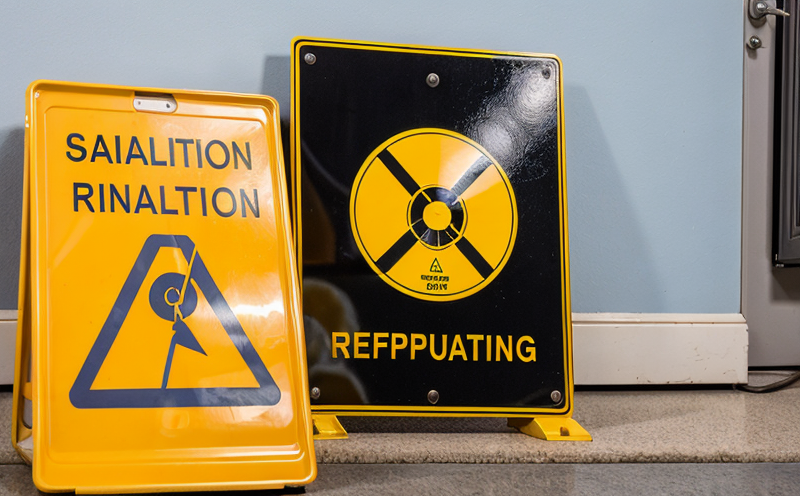ASTM E647 Fatigue Crack Growth Safety Testing in Reactor Steels
The ASTM E647 standard provides a comprehensive framework for evaluating the fatigue crack growth resistance of reactor steels used in nuclear power plants. This testing is critical to ensuring that materials can withstand the cyclic loading conditions they experience over their operational lifetime without developing dangerous cracks that could lead to catastrophic failures.
Reactor environments are characterized by high stress levels, thermal cycling, and aggressive corrosion due to neutron irradiation. These factors necessitate robust materials capable of withstanding fatigue-induced crack propagation under realistic service conditions. ASTM E647 addresses this need through a series of tests that simulate the complex loading scenarios encountered in nuclear reactors.
The testing protocol involves subjecting specimens cut from reactor-grade steels to cyclic loading until they reach a predefined number of cycles or exhibit visible crack growth. The results are used to determine the fatigue life and crack growth rate, which are key indicators of material reliability.
Key aspects of ASTM E647 include:
- Specimen preparation: Precision cutting of specimens from reactor-grade steels
- Cyclic loading: Application of stress cycles within defined temperature ranges to simulate reactor conditions
- Instrumentation: Use of advanced optical and electron microscopy for detailed crack analysis
- Data recording: Continuous monitoring of load, displacement, and crack growth using sophisticated testing equipment
The test results are reported in terms of stress intensity factors (SIF) and the number of cycles to crack detection. These metrics provide critical insights into the fatigue behavior of reactor steels under real-world conditions.
ASTM E647 is widely recognized for its role in ensuring the safety and reliability of nuclear reactor components. By adhering to this standard, manufacturers can demonstrate compliance with international regulations and ensure that their materials meet stringent quality standards.
| Industry Applications |
|---|
| Nuclear power plant construction and maintenance |
| R&D for advanced reactor materials |
| Quality assurance in the nuclear industry |
| Compliance with international safety standards |
The importance of ASTM E647 cannot be overstated, especially given the critical nature of reactor components. By conducting this testing, laboratories ensure that materials are not only capable of withstanding fatigue but also remain safe and reliable under prolonged operational conditions.
Understanding the nuances of this standard is crucial for quality managers, compliance officers, R&D engineers, and procurement professionals involved in nuclear engineering. It provides them with a clear roadmap to ensuring that reactor steels meet the highest safety standards.
Benefits
The benefits of ASTM E647 fatigue crack growth testing are numerous and far-reaching:
- Enhanced Safety: Ensures that materials used in nuclear reactors can withstand cyclic loading without developing cracks, thereby reducing the risk of catastrophic failures.
- Compliance with Regulations: Helps manufacturers meet international safety standards, ensuring regulatory compliance and avoiding potential legal issues.
- Informed Decision-Making: Provides critical data that informs R&D efforts and helps in selecting appropriate materials for new reactor designs.
- Cost Savings: By identifying weak points early in the development process, organizations can avoid costly rework and downtime associated with material failures.
In summary, ASTM E647 testing is essential for ensuring that nuclear reactors are built using materials that can safely withstand the rigors of their operational environment. This not only enhances safety but also supports the broader goals of the nuclear industry in providing reliable power to millions of people worldwide.
Industry Applications
ASTM E647 fatigue crack growth testing finds application across various sectors, particularly in industries where materials must endure cyclic loading and harsh environmental conditions. The primary focus is on the nuclear sector due to its critical role in power generation.
| Nuclear Power Plant Construction |
|---|
| Evaluation of reactor pressure vessels for fatigue resistance |
| Testing of core components such as fuel rods and cladding materials |
| Assessment of structural integrity in containment structures |
In addition to nuclear power, ASTM E647 is also applicable in other sectors that demand high-strength and fatigue-resistant materials:
- R&D for advanced reactor designs
- Maintenance and inspection of existing reactors
- Quality assurance programs in the nuclear industry
- Compliance with international safety standards and regulations
The results from ASTM E647 testing are invaluable in these applications, providing a scientific basis for material selection and ensuring that reactor components meet stringent reliability requirements.
Frequently Asked Questions
Customer Impact and Satisfaction
The implementation of ASTM E647 fatigue crack growth testing has a profound impact on customer satisfaction within the nuclear sector:
- Enhanced Safety: Customers benefit from increased safety, knowing that reactor components are designed to withstand cyclic loading without developing dangerous cracks.
- Regulatory Compliance: By ensuring compliance with international safety standards, customers can avoid legal issues and maintain their reputation as compliant entities.
- Informed Decision-Making: The test results provide critical data that helps customers make informed decisions about material selection for new reactor designs or maintenance programs.
- Cost Savings: By identifying weak points early, organizations can avoid costly rework and downtime associated with material failures. This leads to significant cost savings in the long run.
In conclusion, ASTM E647 fatigue crack growth testing is a vital service that not only enhances safety but also supports broader goals within the nuclear industry. By providing reliable and compliant materials, this service ensures that customers can trust their suppliers to deliver high-quality products.





